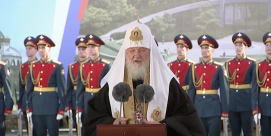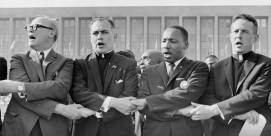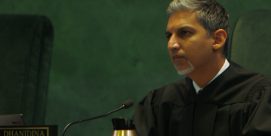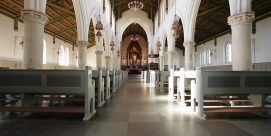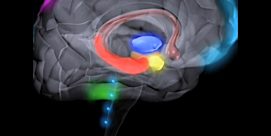In This Episode << SLIDE LEFT TO SEE ADDITIONAL SEGMENTS
Listen Now / Read the Transcript
Listen to this episode now:
[powerpress]
TRANSCRIPT:
Episode no. 1145
BOB ABERNETHY, anchor: Coming up — Lourdes — a village in southern France, where millions of pilgrims come each year, and where many believe a peasant girl saw an apparition of the Virgin Mary 150 years ago.
Father JIM MARTIN (Author, “Lourdes Diary”): People are drawn here for many reasons — for physical healings, but also just to get closer to go in a place with a great community of believers.
ABERNETHY: And the Karmapa Lama, the young leader who may be the next international voice of Buddhism.
DZOGCHEN PONLOP RINPOCHE (Narlanda West Buddhist Center): He is like a spiritual king. You know, naturally, he has that presence, he has that command.
# # #
BOB ABERNETHY: Welcome. I’m Bob Abernethy. It’s good to have you with us.
Leaders of the world’s top industrialized nations, known as the “Group of Eight,” met this week in Japan with the world food crisis on the agenda. But while expressing concern about the rising cost of food and fuel, they did not agree on immediate action.
The consequences of the crisis range from staggering to simple. The World Bank has said it’s received new requests for help that total almost $400 million. The evangelical group Mission Aviation Fellowship said the high price of oil has forced it to cut back on missionary and aid operations.
# # #
BOB ABERNETHY: And in the U.S., the school lunch program has also been hit by the higher food costs. The government-funded program provides subsidized meals to children. Officials told Congress they are now struggling to meet the demand.
# # #
BOB ABERNETHY: On the campaign trail, John McCain and Barack Obama continued to compete for the votes of religious believers. In a video address to the National Right to Life Convention, McCain emphasized his opposition to abortion. Meanwhile, a group of 90 prominent conservative evangelicals said they will support McCain, even though they don’t like everything about him.
Also, Obama’s campaign sent out e-mails asking supporters to be part of a telephone interfaith prayer circle and to consider hosting house parties to talk about values.
# # #
BOB ABERNETHY: In Rome, Pope Benedict XVI asked Catholics around the world to pray for his trip to Australia this week, where he will preside over World Youth Day. The Pope arrives in Australia just as that country is reeling from its own clergy sex abuse scandal. Many Catholics there are hoping Benedict will address the issue as he did when he visited the U.S. in April.
# # #
BOB ABERNETHY: We have a special report today on Lourdes. For Catholics, it’s the most popular pilgrimage site in the world, after the Holy Land. Sick people go to Lourdes hoping for miraculous cures. But the attraction goes beyond physical healing. All those we talked with — the sick and the well — said they had a profound spiritual experience. Our correspondent is Don Kladstrup.
DON KLADSTRUP: It is, in many ways, a spectacle: a spectacle of faith, of devotion, a place of suffering — and of hope. Father Jim Martin:
Father JAMES MARTIN (Author, “The Lourdes Diary”): People are drawn here for many reasons — for physical healings, but also just to get closer to God, in a place with a great community of believers.
Sister NOREEN FALCONE (President, Order of Malta, Washington, D.C.): This is a pilgrimage. We are on a pilgrimage here for a week. But our whole life is a pilgrimage to someone of faith.
(Video from film “The Song of Bernadette”)
KLADSTRUP: On a winter day in 1858, 14-year-old Bernadette Soubirous was gathering firewood near a grotto when she saw an apparition. Afterwards, Bernadette would describe what she saw as simply “a lady in white.” Within a short time, a local woman claimed the waters cured her of paralysis. Pilgrimages to Lourdes would soon begin. People today associate Lourdes with miracles, where healings occur and illnesses are overcome. But over the last 150 years, during which time more than 200 million people have come to Lourdes, only 67 miracles have been confirmed by the Catholic Church.
Fr. MARTIN: Well, you could say only 67 or as many as 67. I think that, you know, people have been drawn to Lourdes not only for the miracles but also because it’s a place of great faith.
KLADSTRUP: Thousands of people have claimed to be cured here. But the Catholic Church does not certify a miracle unless the affliction was incurable and the cure was both unexplainable and permanent.
Every day, 30,000 gallons of water flow from the spring. The water goes into a system of nearby spigots where visitors drink from it, wash with it and carry it home. It’s described as a symbol of devotion. Although chemical analysis ascribes no special properties to it, some people aren’t so sure.
NICOLE DIGKMAN: I had a car accident a few months ago. And I have a whiplash. And yeah, I’m hoping it will be — it will get better.
KLADSTRUP: The seriously ill who come here are known as the “malades” — French for “the sick.” A Catholic humanitarian group, the Order of Malta, brings malades here for a week every year, along with companions and helpers. Noreen Falcone is president of its Washington, D.C. association.
Sr. FALCONE: They are hoping that they’re going to have a miracle — that they’re going to be miraculously cured by going to the waters and to the grotto and asking the Blessed Mother for a miracle to make them well again. Our mission is more to give them support and to hope that they come to terms with their illness.
KLADSTRUP: The domain of Lourdes, as it’s called, covers a large area adjacent to the town. There are 22 places of worship, the centerpiece being the Basilica of the Immaculate Conception. Another basilica — this one underground — seats 25,000. Volunteers escort the malades through the sprawling grounds in carts in order to conserve their strength. Matt Coles is 24. Though never a smoker, he has stage four lung cancer.
MATT COLES: It’s such a blessing to be here, especially with my wife and son.
LUCY COLES: It’s just such a peaceful place, and to be able to come here with Matt, and be part of this and have a healing experience whether it’s spiritual or physical.
KLADSTRUP: Ray Troup came with his 12-year-old son Joe. Troup lives in constant pain due to nerve damage in his lower back. He can’t stand, or sit, for any length of time without severe muscle spasms.
RAY TROUP: I came here to ask God for healing so that I can better support my family. And if it not be his will, then I’m just asking for the grace to get through each day.
KLADSTRUP: Stacy Persichetti is a Georgia woman with two small children. A year and a half ago, she was diagnosed with a malignant brain tumor.
STACY PERSICHETTI: One day you think that you’re just fine and everything’s going along and then the next day, you know, I was told that I had, you know, a level — a grade three cancer and that I’d have 12 months to live.
KLADSTRUP: After lengthy treatment, the cancer was gone. For Stacy, this is a pilgrimage of thanksgiving — and of hope that the cancer won’t return.
Lourdes is a town of 17,000 people, nestled in the foothills of the Pyrenees, near the Spanish border. Six million people come here every year. Hundreds of hotels, restaurants and shops line the narrow streets. The souvenir stores specialize in statuettes, rosaries and containers for the spring water. They are not allowed inside the domain, which is only a few steps away. Here, the atmosphere is one of reverence. People line up to pass through the grotto where the apparition took place. Noreen Falcone:
Sr.FALCONE: When you go over to the grotto and you look at the faces of the people who have come here, you see faith so strong in the eyes of these people.
KLADSTRUP: The stone, touched by hopeful hands for 150 years, worn to a shine. Father Jim Martin . . .
Fr. MARTIN: There’s a sense of holiness, of not only being in a place where something important happened, but also being in a place where 150 years of pilgrims have come and run their hands over that same place.
Ms. PERSICHETI: It was such a powerful moment — the fact that a year and a half later I have no cancer when one doctor had told me that I was going to be dead by this point. Such a miracle to me. And there’s been so many miracles, not only physical but also spiritual miracles that have occurred here.
KLADSTRUP: After passing through the grotto, Ray Troup knelt in prayer with his son.
Mr. TROUP: It’s tangible. All my concerns, all my worries — everything just left. You could just pray so intensely and so easily. It was such a wonderful experience.
UNIDENTIFIED PRIEST (saying prayer): So, as we begin this pilgrimage let us pray, asking the Lord, “Lord bless this candle, which is the sign of faith, of light in our hearts. When we are discouraged, give us light. Help us to see the light of the eternal life that you promised us.”
KLADSTRUP: The words of the apparition to Bernadette, “Go to the spring and bathe there,” are followed by many thousands of those who come here.
Sr.FALCONE: People that come here believe if they bathe in the waters, they’re going to, that’s where the miracle would begin. It has happened. It doesn’t happen every time. It is a cleansing, but it’s a cleansing of your mind as well.
KLADSTRUP: There are 11 pools for women, six for men. Photography inside is strictly forbidden.
(to visitor Patricia Walker): How did it feel to be there?
PATRICIA WALKER: It felt — well it was exciting.
KLADSTRUP: Was it what you expected?
Ms. WALKER: I didn’t know what to expect. But it was pleasant and it was cold.
D. J. CAREY: It was moving, very moving, very spiritual, enlightening and just kind of euphoric.
KLADSTRUP: Bernadette said the apparition told her, “Have the people come here in procession.”
Fr. MARTIN: In Catholic theology, after the celebration of the mass, they reserve what’s called the Eucharistic host, which we consider the real presence of Jesus. And so that’s processed through the street as a way of people coming into contact with Jesus in that way. And it’s a very ancient tradition that goes back to medieval times. And it’s really very popular in Lourdes.
KLADSTRUP: At a special mass during their pilgrimage, the malades and others are anointed. The anointing of the sick is a sacrament in the Catholic Church.
Fr. MARTIN: Through symbols like oil and the laying on of hands, we communicate what the Apostles asked us to do, which is to pass on Christ’s healing power.
KLADSTRUP: Ray Troup:
Mr. TROUP: During the sacrament of the sick, right after the anointing, all of a sudden I was just filled with joy. Since I’ve been here I’ve grown in prayer, patience, peace. I’ve already received a miracle as far as I’m concerned.
Mr.COLE: It’s quite possible that I’ll have cancer for the rest of my life . . .
Ms.COLE: I think the miracle . . .
Mr.COLE: . . . and that’s OK.
Ms.COLE: . . . has already happened, and just allowing us to come here. And I think our faith will only be strengthened by the presence of all these people — by the presence of Mary having come here. And I don’t think that we could — we could ask for anything more.
KLADSTRUP: As night falls on the domain at Lourdes, the torchlight procession begins. Father Jim Martin describes it as an expression of popular devotion.
Fr. MARTIN: People say the rosary all together, in a procession with the malades and their companions and visitors. And they sing Marian songs and hold candles, not only as a way of illuminating the darkness, but also as a symbol of their faith. In most of the world, the people who are poor and sick are ignored. In Lourdes, they are number one.
KLADSTRUP: Noreen Falcone has been to Lourdes 12 times.
Sr.FALCONE: It never gets old. It never gets old. Wellness of body is not really what our life here on this earth is about. It’s really about wellness of mind, wellness of heart, wellness of soul.
KLADSTRUP: Stacy Persichetti
Ms. PERSICHETTI: When you experience Lourdes, even if you never came for a physical healing, I don’t think that you can come away from it without being a changed person.
KLADSTRUP: For RELIGION ↦ ETHICS NEWSWEEKLY, this is Don Kladstrup, at Lourdes.
# # #
BOB ABERNETHY: In other news, Chinese officials announced they will print and distribute thousands of copies of the Bible during the Olympics. The books will be free and bilingual, with the English translation based on the English Standard Version. At the same time, the Chinese government is allowing Olympics visitors to bring in Bibles, but only for their personal use.
Meanwhile, the Chinese also renewed their warnings to the Dalai Lama not to, quote, “sabotage the Olympic Games” by rallying protests against China’s occupation of Tibet.
# # #
BOB ABERNETHY: The Dalai Lama is now here in the U.S. for nearly a month of teaching across the country. He is the world’s best-known representative of Tibetan Buddhism, perhaps of all Buddhism. But now another potential Buddhist leader is emerging.
The Dalai Lama, who turned 73 last Sunday, leads one of the four schools, or denominations within Tibetan Buddhism. The 23-year-old Karmapa Lama, leads another. His supporters believe he may one day succeed the older man as Buddhism’s leading international voice. Recently the Karmapa visited the U.S. for the first time, and Kim Lawton talked with him.
KIM LAWTON: They call him “a reincarnation of the living Buddha,” and this young spiritual leader is already on his way to international superstar status. His name is Ogyen Trinley Dorje. His title is the 17th Karmapa Lama, and after the Dalai Lama, he’s now Tibetan Buddhism’s second-highest ranking spiritual leader. During a recent visit to the U.S. — his first introduction to the West — thousands came out to venues from New York to Seattle to see the 23-year-old Buddhist master.
DZOCHEN PONLOP RINPOCHE (Narlanda West Buddhist Center): The young Kamarpa is the most powerful Buddhist meditation teacher. His scholarship is excellent, and also his youth and his presence makes a profound impact.
LAWTON: The term karmapa literally means “the embodiment of all the activities of the Buddhas.” For the last nearly 1,000 years, a karmapa lama has led the Kagyu tradition within Tibetan Buddhism. Buddhists believe enlightened spiritual masters can choose to be reincarnated in order to come back and help others achieve enlightenment.
This karmapa’s followers see him as part of an unbroken line of Buddhist wisdom.
LAMA SURYA DAS (Western Buddhist Teachers Network): He feels very close to us from the last life and through all of our good aspirations and good things that we have been trying to do together to help bring peace and sanity and wisdom and love into this very volatile modern world.
LAWTON: In an exclusive American television interview, the Karmapa told me he’s pleased with how Buddhism has taken hold in the U.S.
GYALWANG KARMAPA (through translator): Americans have taken a great interest in Buddhism and many Americans have put forth a lot of energy in order to propagate the teachings of Buddhism. And I think they have achieved excellent results within this short period of time.
LAWTON: The Karmapa’s international acclaim is enhanced by the dramatic story that surrounds him. He was born in 1985 to a family of nomads in eastern Tibet. When he was eight years old, he was identified as fulfilling the prophecy left by the previous karmapa who had died in 1981. The Dalai Lama had a dream which confirmed the recognition of the new karmapa and Dorje was taken to live in a monastery. Although some rivals support a different karmapa, Dorje is the only high lama to have been officially recognized by both the Dalai Lama and the Chinese government.
But China keeps a tight reign on Buddhism in Tibet, and when he was 14, Dorje snuck out of his monastery and made a secret escape across the Himalayas by foot, horseback, taxi and train. Eight days later, he arrived in Dharamsala, India, headquarters of the Dalai Lama, where he has spent the past several years in study and meditation.
As the heads of two different streams within Tibetan Buddhism, karmapas and dalai lamas have historically been rivals. That has now changed.
SURYA DAS: This Kamarpa 17th is very close to the Dalai Lama and lives in Dharamsala and they’re like this. So there is no sectarian rivalry or anything. They’re very much close together.
LAWTON: That closeness has led many to suggest that the Dalai Lama, now 73, is grooming the Karmapa as his spiritual heir and the next international voice of Buddhism. It’s a suggestion the Karmapa doesn’t shy away from.
GYALWANG KARMAPA (through translator): I have no special plans to take over any specific role after whenever it is that His Holiness, the Dali Lama, passes away. However, I would be delighted to serve in accordance with the level of confidence and trust the people had in me. It does seem to be the case that I am receiving more and more recognition in the world. And my main aspiration is that I use this recognition for a beneficial purpose.
LAWTON: Because the Dalai Lama heads the Tibetan-government-in exile, there is much speculation about the Karmapa’s potential role in China-Tibet politics as well. He avoided such sensitive topics during his visit to the U.S., and steered questions about politics back to the practice of Buddhism in Tibet.
GYALWANG KARMAPA (teaching, through translator): It’s important to understand that cherishing sentient beings, loving sentient beings, is the root of compassion.
LAWTON: As his public role now expands, expectations about his future leadership are high. With his trip to the U.S., the teachings he once gave to private audiences at his monastery are being sold on DVDs and posted on the Internet.
PONLOP RINPOCHE: I’m not talking politics but from spiritual point of view. You know, he is like a spiritual king. Naturally he has that presence, he has that command.
LAWTON: The Karmapa is learning English, although not yet confident enough to teach or give an interview in the language. But a few words trickle through.
GYALWANG KARMAPA (speaking English): I need a dictionary.
LAWTON: He can come across as uncomfortable, reserved, even stern. Yet there are flashes of humor, too.
GYALWANG KARMAPA (speaking English): I forget the translator.
LAWTON: It’s easy to forget he’s only 23. During one Seattle appearance, he mentioned that he used to like reading “X-Men” comic books, but then people stopped giving them to him. So we got him one. In many ways, he’s been isolated, his responsibilities pressed upon him since he was a small child.
GYALWANG KARMAPA (teaching, through a translator): And I would think thoughts like, why are my attendants who are disciples of the Karmapa making my life so miserable? Why are they locking me in a box and putting on the lid?
LAWTON: Followers say this karmapa is well aware that technology has made the world a smaller place, and that Buddhism must stay relevant.
GYALWANG KARMAPA (through translator): Because of the Internet, we live in an age in which information can travel very rapidly to different places. Before, it used to be the case that just having a karmapa alive was good enough for everyone. People didn’t need a lot of information about who the karmapa was or what the karmapa was doing.
SURYA DAS: He has continuously talked about not holding on to things just because they’re old, but to adapt, and keep the essence, but to adapt to new times and places.
LAWTON: This karmapa believes that Eastern Buddhists and Western Buddhists can learn from one another.
GYALWANG KARMAPA (through translator): The essential points of Buddhism are beyond culture and beyond traditions.
LAWTON: Given the level of devotion he’s already cultivating in the West, his followers say this karmapa lama may well be the future face of Buddhism around the world.
I’m Kim Lawton in Seattle.
# # #
BOB ABERNETHY: There’s a renewed dispute over who first wrote the popular Serenity Prayer, which says, in part, “God grant me the serenity to accept the things I cannot change.” It’s long been credited to the late theologian Reinhold Niebuhr, but now a Yale historian has found several references to the prayer before the theologian is said to have written it. The historian said perhaps Niebuhr had unconsciously heard the earlier versions and blended them into one of his sermons. But Niebuhr’s daughter and one of his biographers insist the prayer was Niebuhr’s.
# # #
BOB ABERNETHY: Finally, John Templeton died this past week at the age of 95. He made a fortune in mutual funds and then turned to philanthropy, supporting research into the relationship between science and religion. The annual Templeton Prize for Progress in Religion is the world’s largest financial award to any one person. Templeton believed there’s truth to be learned in all religions. He once said he was funding humility, adding, “You shouldn’t believe you know it all.”
# # #
BOB ABERNETHY: That’s our program for now. I’m Bob Abernethy. There’s much more on our Web Site, including more on religion and politics on our “One Nation” page. Audio and video podcasts of the program are also available. Join us at pbs.org.
As we leave you, music from the torchlight procession at Lourdes.
Back to Article Finder: Stories by Week
© 2008 WNET-TV. ALL RIGHTS RESERVED.
Prepared by Burrelle’s Information Services, which takes sole responsibility for accuracy of transcription. No license is granted to the user of this material other than for research. User may not reproduce any copy of the material except for user’s personal or internal use and, in such case, only one copy may be reproduced, nor shall user use any material for commercial purposes or in any manner that may infringe upon WNET-TV’s copyright or proprietary interests in the material.

